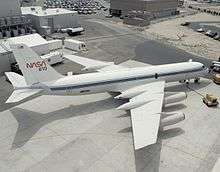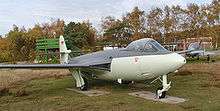Anti-shock body

An anti-shock body (also known as Whitcomb body or Küchemann carrot) is a pod positioned on the leading edge or trailing edge of an aircraft's aerodynamic surfaces to reduce wave drag at transonic speeds (Mach 0.8–1.0).
Wing trailing edge

Most jet airliners have a cruising speed between Mach 0.8 and 0.85. For aircraft operating in the transonic regime (Mach 0.8-1.0), wave drag can be minimized by having a cross-sectional area which changes smoothly along the length of the aircraft. This is known as the area rule, and is the operating principle behind the design of anti-shock bodies. Reducing wave drag improves fuel economy.
Anti-shock bodies, apparently developed in the Soviet Union's TsAGI research institute and serving a dual purpose as undercarriage bogie fairings, were first applied to the Tupolev Tu-16 jet bomber. The Tu-16 flew for the first time in April 1952 and the bodies were to remain a unique feature of the company's products up to and including the Tupolev Tu-154 designed in the mid-1960s.
Outside the Soviet Union the theory was developed in the early 1950s by Richard Whitcomb at NASA, and Dietrich Küchemann at the British Royal Aircraft Establishment, leading to their appearance on aircraft such as the Convair 990 and the Handley Page Victor bomber; and their becoming known as 'Whitcomb bodies' or 'Küchemann carrots'.
Modern jet aircraft use supercritical airfoils which decrease wave drag significantly. Further optimization can be achieved through careful design of wing body fairings, engine nacelles, flap track fairings, and wingtip fuel tanks. Due to the prevalence of supercritical airfoils, other design features with the sole purpose of minimizing wave drag (such as the anti-shock bodies on the Convair 990) are rare in modern aircraft.
Leading edge root

On the Hawker Sea Hawk, the prototypes experienced high tail drag when approaching transonic speeds. To resolve this, an anti-shock body was subsequently fitted to the leading edge of the junction between the vertical fin and tailplane.
References
External links
| Wikimedia Commons has media related to Anti-shock bodies. |